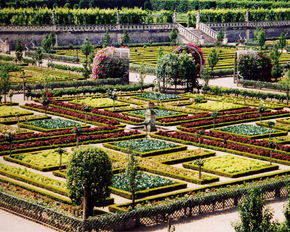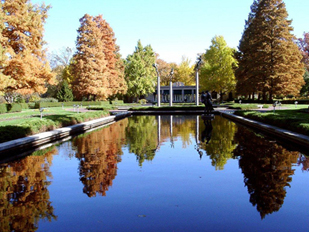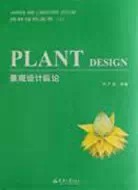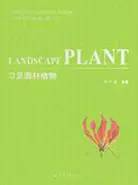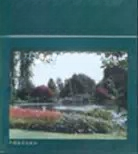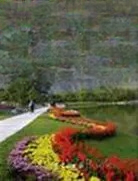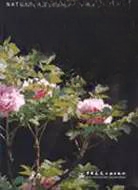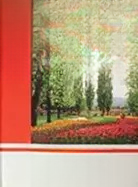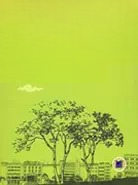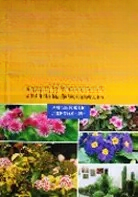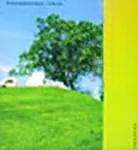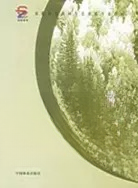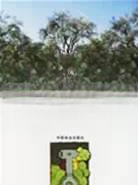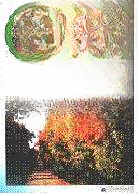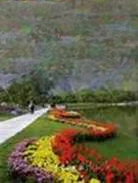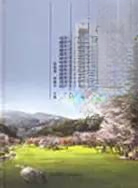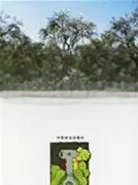『Planting』Garden plant landscaping design
1. Gardens
" Garden " means that within a certain area, natural landscapes are utilized and transformed, or landscapes are artificially opened up, combined with the planting of plants and the arrangement of buildings, to form an environment for people to appreciate, relax and live.
" Lin " means plants and forests.
Garden - explained in the "Cihai" as "a green space often surrounded by permanent hedges, planted with trees, fruit trees, flowers or vegetables and other plants, and raised and exhibited animals." In ancient books, it is also called garden, enclosure, garden pavilion, courtyard, garden pool, mountain pool, pool pavilion, villa, mountain villa, forest spring, forest pavilion, pavilion, garden, landscaping, etc. according to its different nature; the United States and the United Kingdom call it Garden, Park, Landscape Garden, Landscape Architecture.
Landscape Architecture: In order to improve the ecological environment and meet the needs of landscape and recreation, within a certain range, it is based on certain artistic principles and scientific and engineering technology laws, mainly using plants, buildings, rocks, water bodies and other materials to create a beautiful green space.
2. Landscape Plants Scenery Design
1. Traditional Definition
"Landscape Plants Scenery Design" == "Plants Incorporation" means using trees, shrubs, vines and herbaceous plants as themes, and through artistic techniques, giving full play to the natural beauty of plants such as shape, lines, and colors to create beautiful garden plant landscapes.
2. Modern definition
The garden plants used in urban green spaces are based on their biological, ecological and horticultural characteristics. According to certain scientific laws and artistic rules, various types of artificial plant communities or scenic spots are combined to achieve specific ecological, beautification effects and practical functional values.
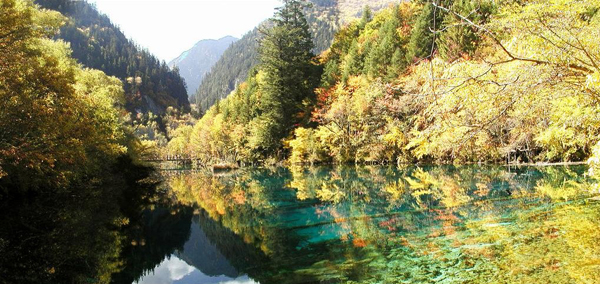 |
Landscape Architecture
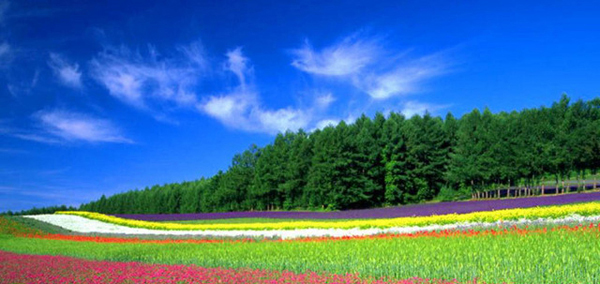 |
The landscape is mainly composed of herbs, with large blocks of color and large lines.
|
| ||
| Natural arrangement of plants - American gardens | Natural arrangement of plants - American gardens |
3. Comparison between traditional and modern concepts
Tradition | modern | |
Function | Watch | Ornamental, ecological, practical |
in accordance with | Traditional Art | Natural sciences, engineering technology |
Effect | Highlight the plant itself | Comprehensive group scene |
scale | Small | Big and Small |
In foreign countries, garden design = plant landscaping design. Plant landscaping is not only the main task of urban garden construction, but also represents the direction of garden development at home and abroad today.
3. Domestic: Plant Landscape Design of the Summer Palace
1. Stone Garden of Yiyun Pavilion in the Summer Palace
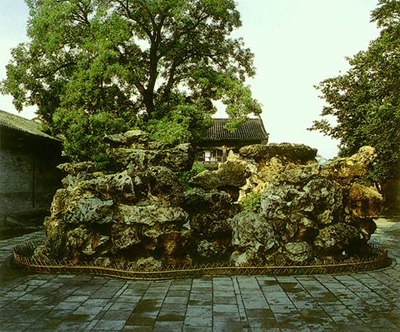 |
The clever use of blue bricks, green trees, strange rocks and plants, and classical garden modeling elements makes the scenic spot profound.
2. Lotus Pond in the Garden of Harmony and Fun in the Summer Palace
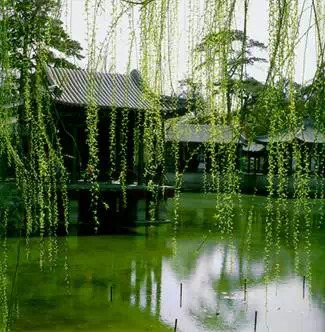 |
The water surface is rippling with green waves, and willows are luxuriantly hanging by the pond. Willows planted by the waterside are not only beautiful in shape, but their reflection in the water is also an important landscaping element in the garden waterscape.
3. The Garden of Harmony and Fun in the Summer Palace
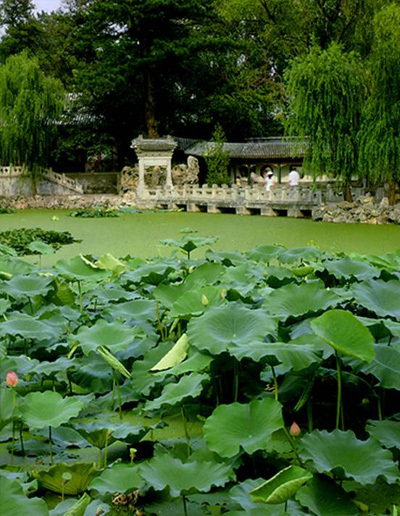 |
The lotus not only has a transcendental significance to humans, it is also widely used in the creation of waterscapes; its advantages also lie in its graceful leaf shape and the soundscape created by rain hitting the lotus leaves.
4. Tower of Buddhist Incense, Summer Palace
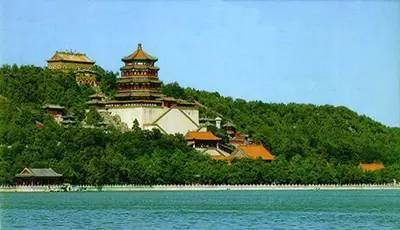 |
The arrangement of plants around large buildings nestled in the mountains and beside the water also requires a large amount of effort. The lush and green mountains first provide the base for the entire picture, and then the buildings are used to embellish it, giving the scenery a very good effect.
5. A tour through the Summer Palace
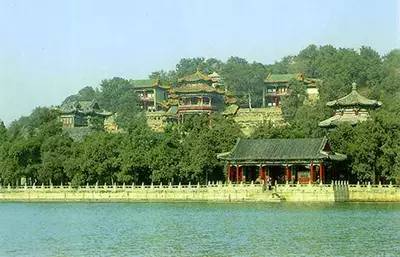 |
The water surface is like a mirror, the mountains are lush and green, and the mountains and water complement each other; the buildings in the forest are carved with beams and painted with rafters, and walking among them, you will feel the fullness of the forest and rivers.
6. Stay at Yunyan in the Summer Palace
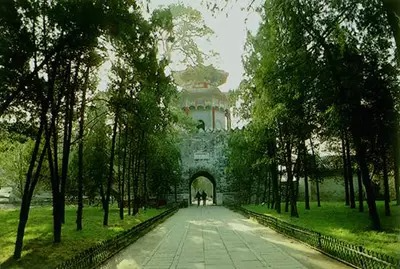 |
Tall trees line the road, and the intersection of sight in the swaying shadows points directly to the main building. The use of street trees here not only sets off the atmosphere, but also guides the sight.
7. Zhiyu Bridge in the Garden of Harmony and Fun in the Summer Palace
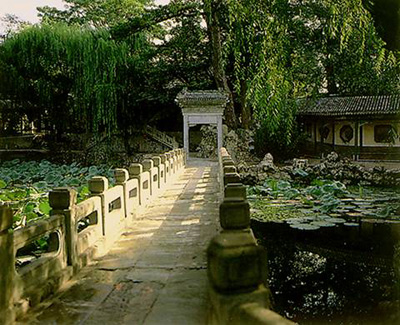 |
The stone bridge crosses the water, and the appearance of lotus in the gurgling water softens the "stalemate" between the bridge and the water, one soft and one hard, one static and one dynamic, making the whole picture harmonious.
8. Winter in the Summer Palace - Baoyun Pavilion
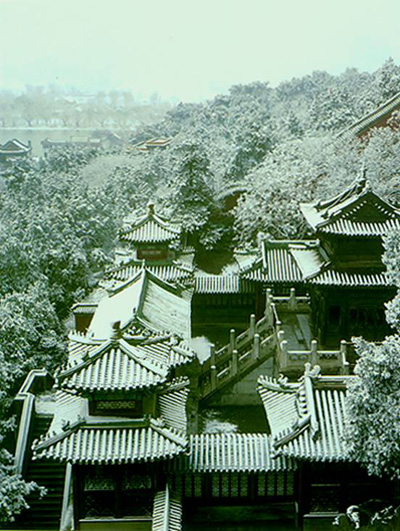 |
As the seasons change, the landscapes of different seasons vary. In the winter in the north, all trees wither, so the use of evergreen species and the creation of snow scenes are particularly important.
9. One of the trails on the back hill of the Summer Palace
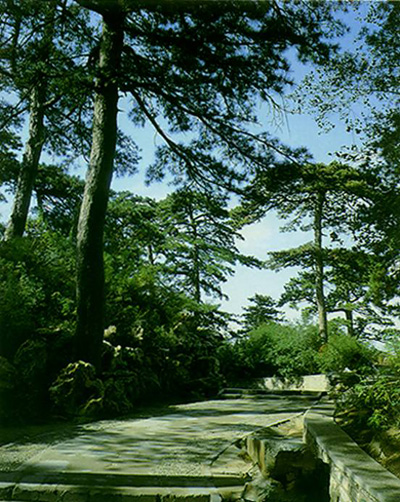 |
The forest paths, green trees, bluestones, plant communities, and the embellishment of famous and ancient trees make the secluded paths interesting.
10. Duobao Pagoda in Huacheng Pavilion, Summer Palace
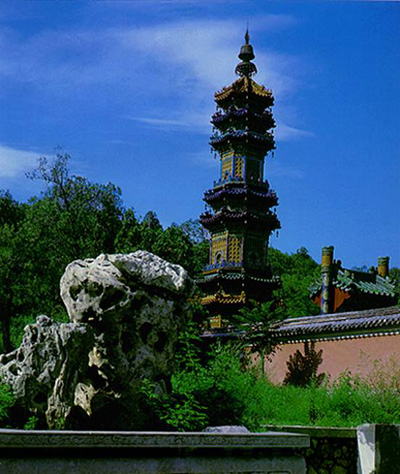 |
The plant landscaping uses slow-growing evergreen, highly ornamental and theme-appropriate tree species to highlight the solemnity of the pagoda.
11. Jiqingxuan Pavilion, Summer Palace
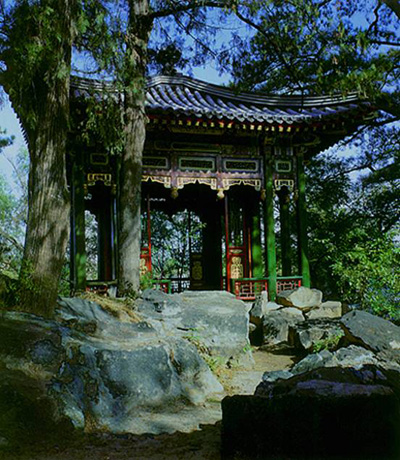 |
Ancient trees, stubborn rocks, pavilions, winding paths, the ancient trees in the entire scenic spot are not only landscaping elements, but also play a role in governing the style.
4. Domestic: Plant landscaping in the Humble Administrator's Garden
1. Entrance plant landscape
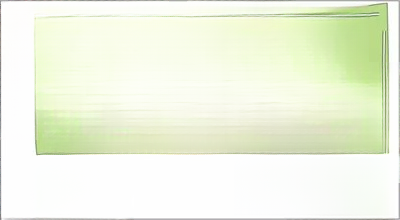 |
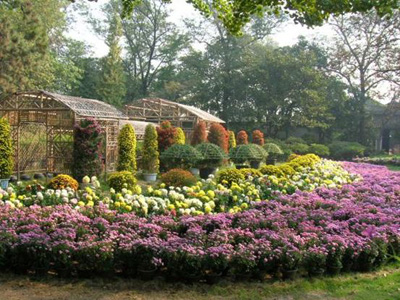 |
Place seasonal flowers and shaped plants at the entrance to highlight the entrance
2. Haitangchunwu
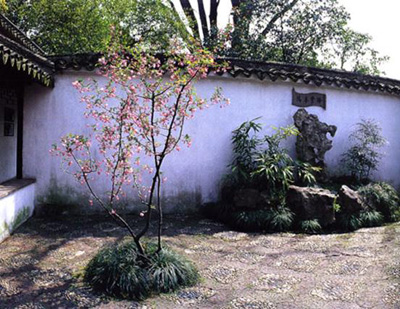 |
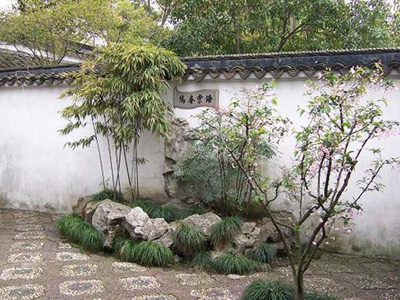 |
Begonias and bamboos are planted, with begonias being the main ornamental object. In addition, a tall elm tree is planted in the southeast corner of the courtyard as an embellishment.
3. Xiuqi Pavilion
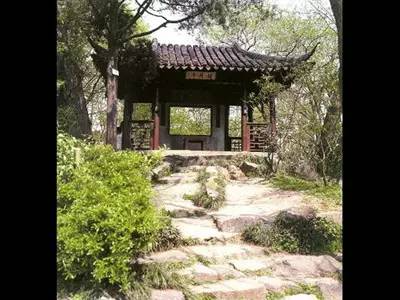 |
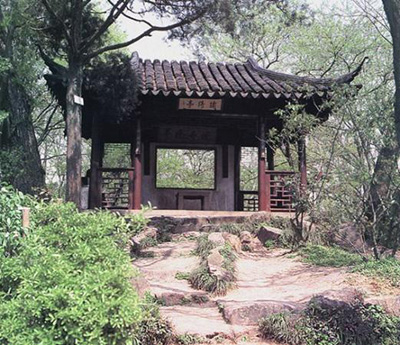 |
Located on the rocks, the five larger trees are arranged according to the principle of larger ones near and smaller ones far away, thus maintaining an asymmetrical balance.
4. Xuexiangyunwei Pavilion
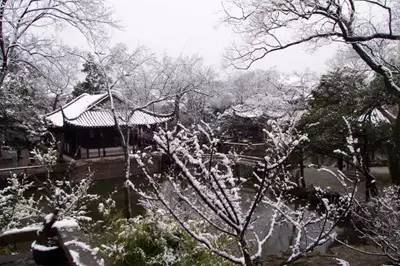 |
Located on a small hill in the middle of the garden, there are many wintersweets planted around it, in addition to several tall trees. During the cold winter, the wintersweets that fight against the snow are in full bloom. The fragrance of the flowers and the auspicious snow complement each other, making it a great place to enjoy the winter scenery in the garden.
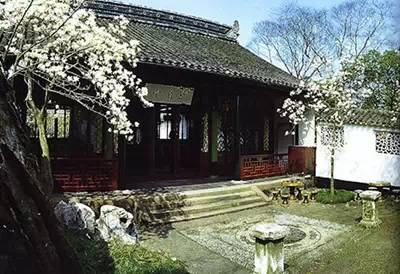 |
There are two trees, one large and one small, on the left and right sides. The large one is a magnolia, which is the main object of appreciation in the courtyard, and the small one is an osmanthus, which serves as a foil.
5. Central part of Humble Administrator's Garden
 |
Looking at the scenery in the garden through the network of interwoven tree branches or the gaps between sparse branches and leaves will provide you with rich changes in spatial levels and enhance the sense of depth of the scenery.
6. Tingyuxuan Courtyard in Humble Administrator's Garden
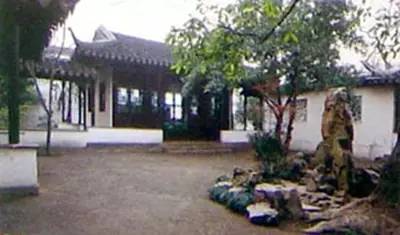 |
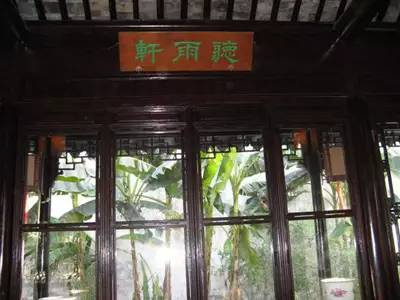 |
Banana trees are planted in one corner of the courtyard, and the sound effect of rain hitting the banana trees creates a rainy atmosphere. In addition, osmanthus, magnolia, peach, bamboo, etc. are planted as a foil, making the scenery change in each season.
5. Abroad: British garden plant landscape design
1. Stowe Park
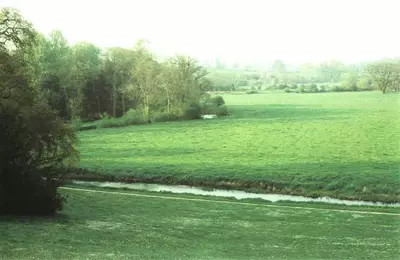 |
The landscape of sparse woods and grasslands makes the entire garden seamless, expanding the visual range and sense of space.
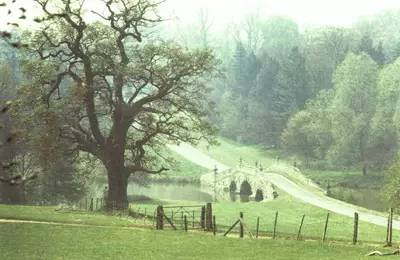 |
The solitary big tree, set against the backdrop of the natural dense forest, makes the whole picture more poetic. This is a typical picture of British natural scenery.
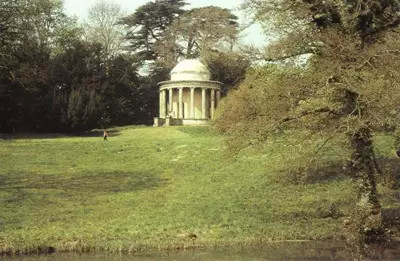 |
The use of gently sloping lawns and natural green woods makes the white marble building stand out.
2. Stourhead Park
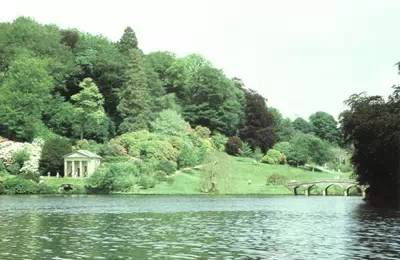 |
The lakeshore has beautiful scenery, with grass extending directly into the water. Against the backdrop of the varied dark green woods on the skyline, there are dotted low shrubs in red, yellow, purple, and white. Swans are cruising on the lake, creating a colorful picture.
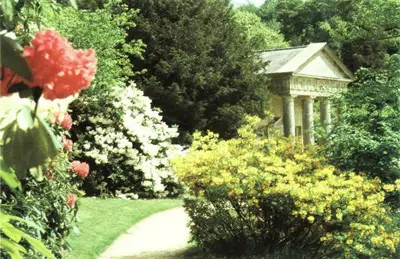 |
With dense forests as its background, there are rhododendrons of various colors on both sides of the white Flower Temple. The white building is hidden among the flowers, and its reflection in the water forms a touching picture.
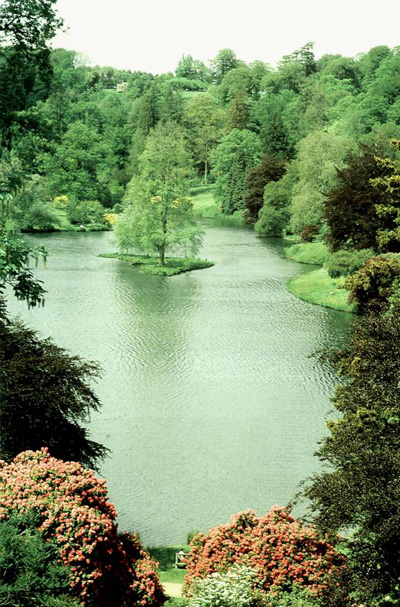 |
The solitary tree on the small island in the lake becomes the visual focus of the entire park. Plants of different seasons and species are used as the background. Walking along the lakeside road, the scenery on the island and the opposite bank keeps changing, achieving the effect of different scenery with every step.
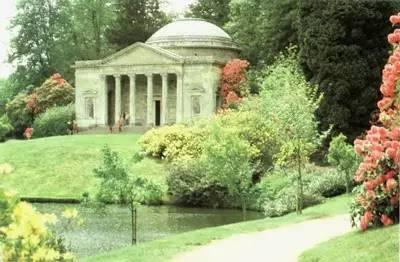 |
The open grassland near the lake slowly extends into the lake, with dense forest in the background and various flowering plants and small trees in the foreground that shade the white building.
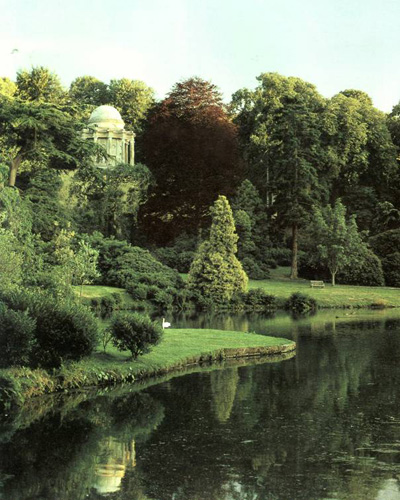 |
The Temple of Apollo is located on a high ground, surrounded by trees on three sides, with a sloping grassland in front that stretches all the way to the lakeshore. The grassland on the shore is flat and has clumps of trees on it. From the opposite bank, the Temple of Apollo seems to be standing above the sea of trees.
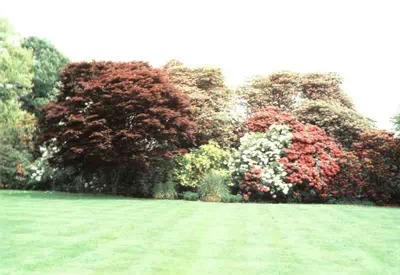 |
Rhododendrons of different heights and colors are dazzling, and various colorful leaf trees make the garden scenery more colorful.
3、邱园(Royal Botanic Gardens,Kew)
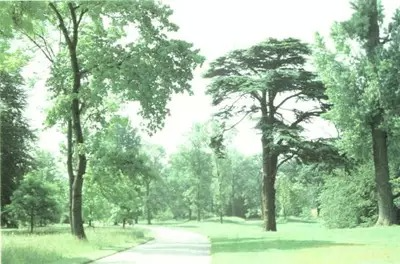 |
The arrangement of trees in Kew Gardens is scientifically classified and creates a beautiful landscape effect. People can learn about botany and indulge in artistic enjoyment here.
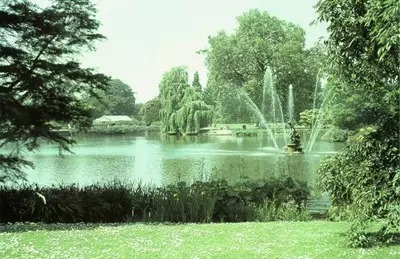 |
The natural pond next to the palm greenhouse has a gentle slope formed by the grass between the road and the water surface, which gradually extends into the water. There are clumps of wetland and marsh plants extending from the roadside into the water. In these places, it is difficult to perceive the obvious boundary between the pond and the shore.
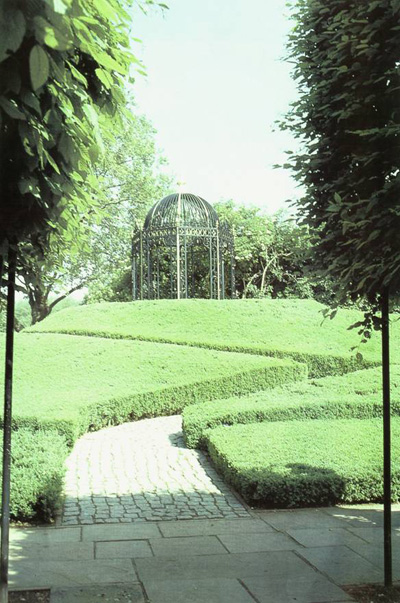 |
Large areas of neatly trimmed boxwood paving and a slightly elevated metal pavilion showcase the gardens of the Elizabethan era.
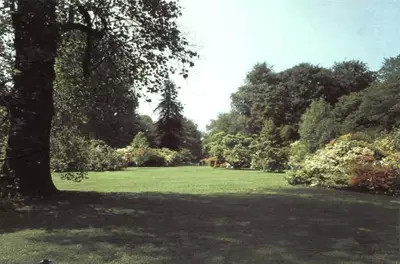 |
The ancient trees with beautiful and full crowns are witnesses to Kew Gardens’ history. Some large trees are directly connected to the grassland, while others are dotted with colorful shrubs in front of them, forming grassland spaces of different sizes, and on the grassland stand graceful solitary trees.
4. Nymans Park
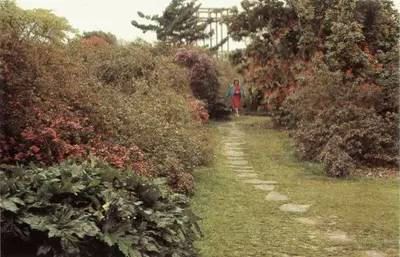 |
Naturally arranged plants create a natural and rustic path that leads visitors to the observation deck on the top of the hill.
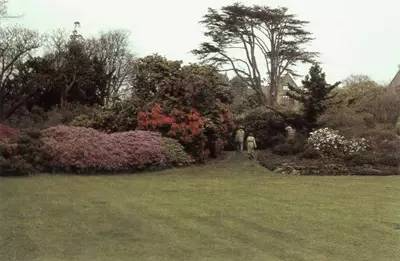 |
The plants on the top of the hill are clearly divided into primary and secondary plants with rich layers.
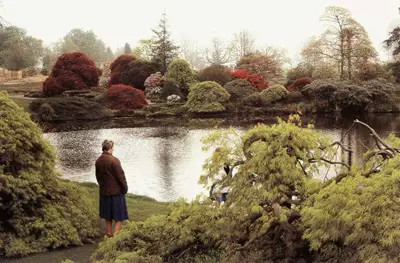 |
The flowering shrub landscape around the pool, mainly maple trees and rhododendrons, is rich in layers, colorful, and well-managed.
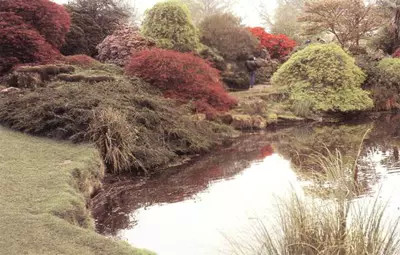 |
The lawn slope protection and flat vegetation are naturally connected with the water surface.
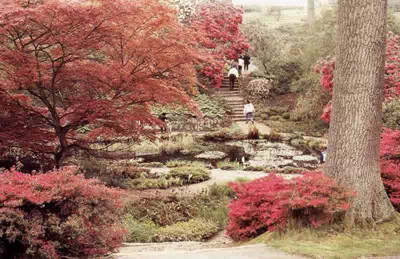 |
The well-arranged natural trees make the whole space full of natural interest.
6. Abroad: French garden plant landscape design
1. The Gardens of the Chateau de Vaux-le-Vicomte
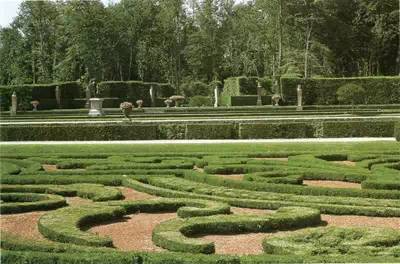 |
The embroidered flower bed, with purple-red brick as the background, sets off the boxwood pattern very delicate and clear, with strong color contrast. The corners of the flower bed are dotted with neat yew and various vase decorations. The large area of the flower bed is in harmony with the proportions of the mansion building and the entire garden.
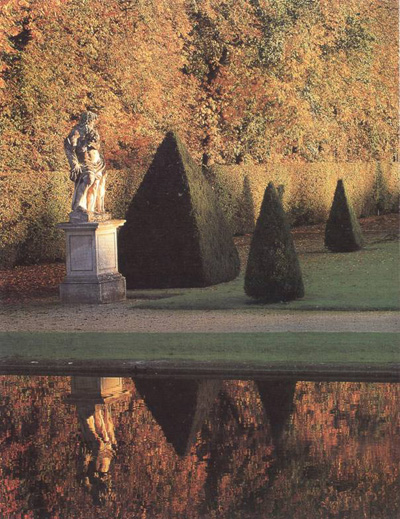 |
Autumn scenery in the garden. The green shaped plants and lawns contrast sharply with the golden elm hedges and background trees, while the water, stones and plants are very harmonious and rhythmic.
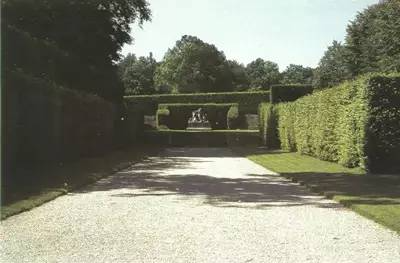 |
The closed forest garden forms a strong contrast with the open garden. The tall trees form the background of the garden and the space extending to the south. The landscape of the formal garden is often more varied when viewed from the side.
2. Le Jardin du Chateau de Versailles
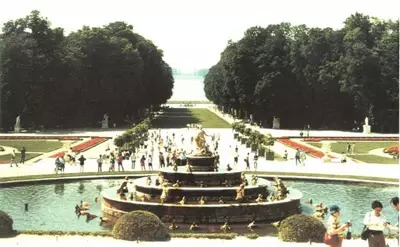 |
Looking west from the water flower bed, there are dense forests on both sides of the central axis. The tall trees are neatly trimmed, which enhances the three-dimensional sense and spatial changes of the central axis.
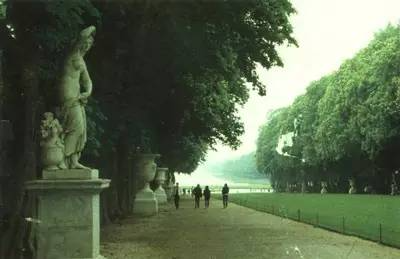 |
On both sides of the King's Avenue are tall European horse chestnut trees, which are in harmonious proportion with the wide avenue and set off the elegance and simplicity of the marble statues and vase ornaments placed under the trees.
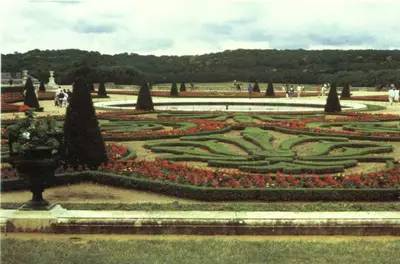 |
The South flower bed is a large, low embroidery flower bed, forming an open space, which contrasts with the North flower bed at the north end, showing the technique of seeking change in unity.
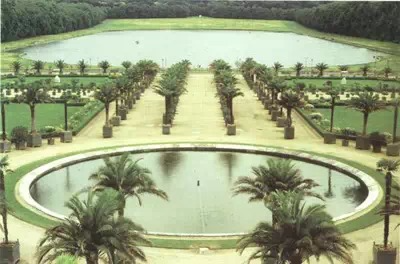 |
The potted subtropical plants in the new citrus orchard create a strong exotic atmosphere, while the lush forested hills and the Swiss Lake in the distance form an open, outward-looking space with lake and mountain scenery as the main theme.
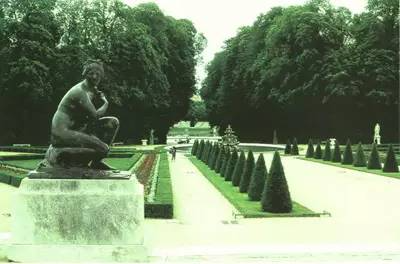 |
The North Flower Bed uses tall trees to form an enclosed inward space, surrounded by palaces and gardens, and is very quiet.
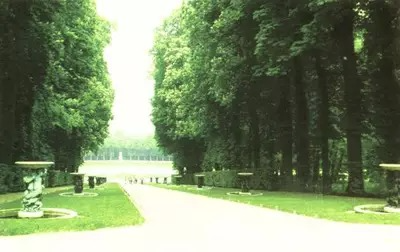 |
The Waterlight Boulevard is a ramp that crosses the forest garden. The dark and narrow space formed by the tall and dense trees on both sides makes the Neptune Spring, which is not very large in itself, look very spectacular.
3. Le Jardin du Chateau de Fontainebleau
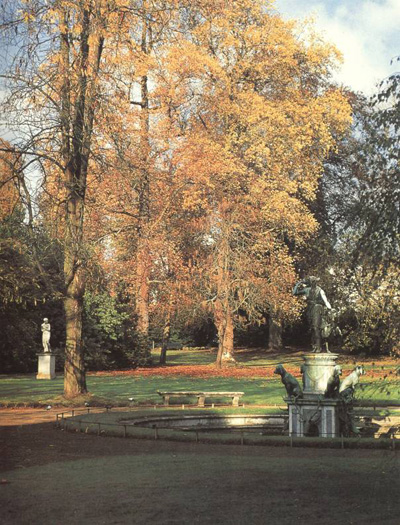 |
A large number of sycamore trees and larch trees are planted in Diana Garden, making the garden appear quiet, deep and full of wildness.
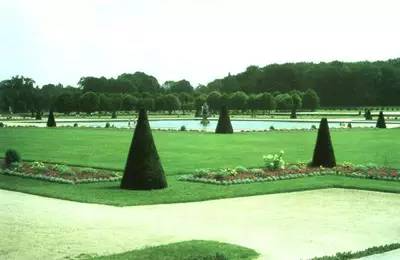 |
The Tiber Flower Bed is a huge square flower bed that uses boxwood hedge patterns, large lawns and shaped plants to create a far-reaching sight and a vast spatial effect. It is the most prominent landscape of the Fontainebleau Palace.
4. Seals (Seals)
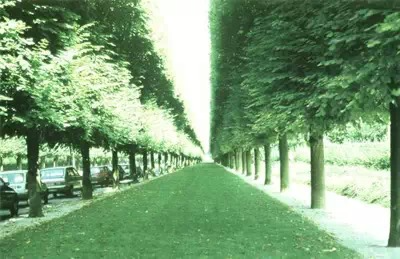 |
There is a wide boulevard formed by neatly trimmed trees, which extends all the way to the city's main road and serves as the city's landscape green belt.
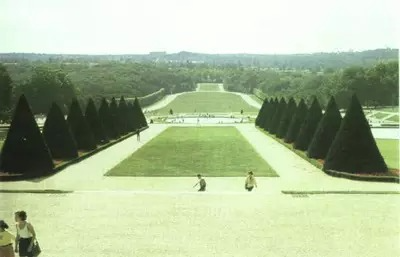 |
In the middle of the wide road west of the large pond is a large green carpet-like lawn, just like the King's Avenue in Versailles, except that there are neatly arranged conical yew trees on both sides, and the view along the road is broad and far-reaching.
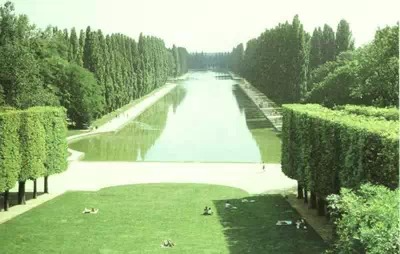 |
The tall and neatly arranged tower-shaped trees form a landscape axis running through the north and south, making the entire Grand Canal look even more magnificent and giving the entire So Garden an imposing appearance.
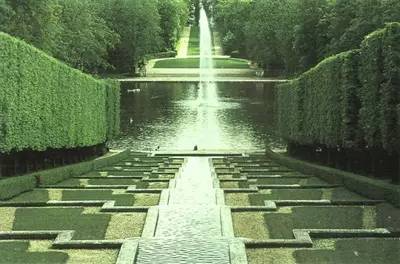 |
The neatly trimmed tree wall makes the entire waterscape more spacious and layered. The scenery is magnificent, immersive and exciting.
 |
Shaped trees form the frame of the entire small space, and pleasant lawn and flower beds form an enclosed and intimate resting place.
 |
Towering Italian poplars are planted on both sides of the canal. Their tall and straight posture forms a sharp contrast with the horizontal plane. Coupled with the surging and spectacular waterfalls, the waterscape is both dynamic and static, leaving a deep impression on people.
5. Gardens of the Het Loo Palace, Netherlands
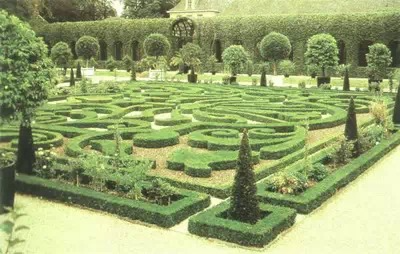 |
The Queen's Garden is arranged in a grid-shaped green arch and has the characteristics of a private garden. "Feminine" flowers such as lilies and aquilegia are planted in the garden to symbolize the Virgin Mary.
6. Gardens of the Herrenhausen Palace, Germany
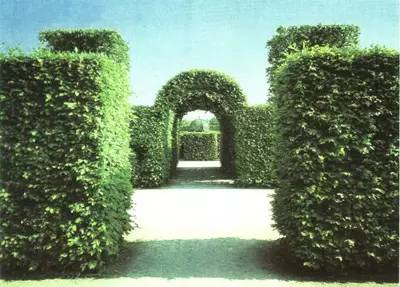 |
Green hedges and green arches serve to guide the space.
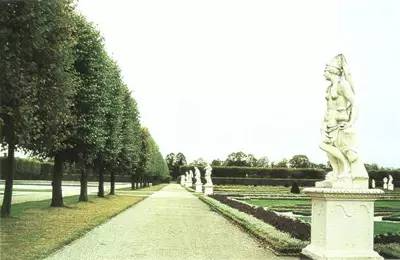 |
A neatly trimmed tree wall surrounds the large flower bed, serving as a backdrop and setting off the flower bed.
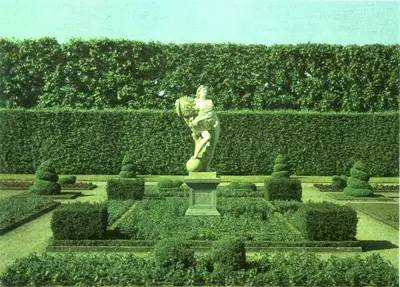 |
The neatly manicured double green wall serves as a backdrop to the statue.
7. Recommended books on garden plant landscaping design
1. Title: Landscape Plants for Gardening (Volume 1) A Comprehensive Discussion on Landscape Design Author: Liu Shaozong Publisher: Tianjin University Press Publication Date:2003-07-01 ISBN:756181770 Price: 118 RMB Introduction: This book is the first volume of "Landscape Plants". It explains the basic theories and knowledge of landscape gardening design, and introduces the history, current situation, and development prospects of domestic and foreign gardens in a graphic way, as well as a large number of excellent examples of domestic and foreign garden design. The book contains more than 300 color pictures and more than 100 line drawings. This book is suitable for landscape architects, urban planners and environmental designers, and is also a good teacher and friend for teachers and students of related majors in colleges and universities.
2. Title: Landscape Plants (Part 2): Common Landscape Plants/Selection of Landscape Plants Author: Liu Shaozong Publisher: Tianjin University Press Publication Date:2003-06-01 ISBN:7561817711 Price:330RMB Introduction: This book is the second volume of "Landscape Plants". It mainly introduces more than 600 kinds and varieties of garden plants that are often or widely used in urban greening or scenic area construction in various regions. It is divided into 8 chapters according to the landscape form of the plants themselves: evergreen trees, evergreen shrubs, deciduous trees, deciduous shrubs, rattan trees, bamboo, palm trees and herbaceous flowers. It focuses on describing the origin, distribution, morphological characteristics and ornamental features of each plant, and briefly explains the phenological period, habits, application and main diseases and pests.
3. Book Title: Plant Landscaping Author: Su Xuehen Publisher: Forestry Publishing House Publication date: 1994.4 ISBN:7-5038-1067-X Price:28RMB Introduction: This book discusses the landscaping of lakes, ponds, streams, springs, embankments, islands, watersides, and water surfaces in terms of the combination of water bodies and plants. It gives vivid descriptions of artistic composition and applicable plant species using famous gardens in famous cities as examples. In terms of the combination of architecture and plants, this book emphasizes that the combination of architecture and plants should be mutually beneficial and complementary, and should be coordinated in form, volume, and color. It also specifically discusses the plant arrangement and landscaping techniques of doors, windows, walls, and corners of buildings. Roof gardens are currently only set up in some public buildings and a few restaurants and hotels. This book briefly describes the plant arrangement of roof gardens. In terms of the combination of streets and plants, this book emphasizes that plant landscaping should be carried out under the premise of obeying traffic functions and traffic safety. It discusses the planting design of highways, lane dividers, street tree green belts, and sidewalk green belts, and especially focuses on the plant landscaping of scenic spots and park paths. This book has made contributions to improving the scientific and artistic level of plant landscaping, and I hope it will be helpful to everyone.
4. Book title: Plant Landscape Design (a series of textbooks for design majors in colleges and universities) Author: Chen Yuehua/Wang Xiaohong Publisher: National University of Defense Technology Press ISBN:781099207 Price: 22RMB Introduction: With the development of the times, people's demands for the ecological quality and landscape quality of the living environment are constantly increasing, and the call for returning to nature is becoming stronger. The status of plants in gardens has changed from the past foil and background to the main scenery and subject, and plant gardening will also become the mainstream of modern garden development. This book introduces the knowledge about plant landscape design, which is suitable for professionals in gardening, horticulture, urban planning, landscape design, architecture, and college teachers and students. With the development of the times, people's demands for the ecological quality and landscape quality of the living environment are constantly increasing, and the call for returning to nature is becoming stronger. The status of plants in gardens has changed from the past foil and background to the main scenery and subject, and plant gardening will also become the mainstream of modern garden development. This book introduces the knowledge about plant landscape design, which is suitable for professionals in gardening, horticulture, urban planning, landscape design, architecture, and college teachers and students.
5. Book Title: Plant Landscape Author: Lu Sheng Editor Publisher: Meteorological Press Publication date: 1st edition, May 2004 Place of publication: Beijing ISBN:7-5029-3781-1 Price: 36.00RMB Introduction: The book is divided into five chapters, which respectively introduce the basic principles of plant landscaping, the ecological principles of plant landscaping, the ornamental characteristics of garden plant landscapes, the landscaping functions of trees in gardens, the artistic effects of matching plantings, the forms of planting, and the plant landscape design of urban green spaces.
6. Book Title: Ecological Environment Art Plant Landscape Atlas. Flowers Author: Jiang Rongxian Publisher: China Architecture & Building Press ISBN:711204437 Price: 68RMB Introduction: This atlas is a graphic book that combines popular science and art. It is a reference atlas of ecological environment plants. It mainly introduces the relationship between flowers and humans, as well as the use, development, protection and role of flowers in cities. It is a quality book for people to go from necessarily loving beauty to loving beauty freely. It contains 300 exquisite color pictures, including more than 200 kinds of flowers, divided into three chapters of "Ancient Famous Flowers", "Essence of Ornamental Flowers and Trees", and "Top Quality Environmental Flowers", with 17 sub-topics.
7. Book Title: Flowerbed Plant Landscape (Exquisite) /Modern Garden Plant Landscape Series Author: Zhou Hougao Publisher: Guizhou Science and Technology Press Publication Date:2006-05-01 ISBN:780662428 Price: 128 RMB Introduction: The series is illustrated with a large number of exquisite pictures to show the characteristics, landscaping functions and garden applications of plants. The pictures of plant landscaping are real-life photos taken in major cities across the country from 2004 to 2005. They represent the highest level of plant landscaping art and technology and have very important reference value. At the same time, the series introduces the scientific name, morphological characteristics, identification points, breeding points, and cultivation and maintenance points of the included plants. This series is divided into 11 volumes according to the characteristics and landscaping functions of garden plants, including aquatic plant landscape, ground cover plant landscape, shade plant landscape, flower bed plant landscape, hedge plant landscape, aromatic plant landscape, vine plant landscape, street plant landscape, courtyard tree and shrub landscape I, courtyard tree and shrub landscape II, lawn grass and ornamental grass landscape.
8. Book Title: Architecture and Urban Space Greening Planning Author: (Japan) Architectural Institute of Japan Publisher: Machinery Industry Press Publication Date:2006-1-1 ISBN:7111178092 Price: 33RMB Introduction: Urban greening in many countries is becoming more and more complete, new methods are introduced in the planning of greening buildings and urban spaces, and the technology has also made great progress. However, due to poor follow-up management after greening, trees grow excessively and spread, and it is not uncommon to see that the greening completed with great effort has almost no use value. Greening, from the scale of the earth to the scale of ornamental plants, includes many various issues, and research related to greening will become increasingly important in the future. The first part of the book mainly explains the environmental engineering issues in greening, the middle part focuses on management methods and environmental standards related to greening, and the last part mainly explains the greening design methods and a large number of typical cases. These specific cases are very unique and have important reference value. This book is suitable for study and reference by architects, urban planners, gardeners, environmental and landscape designers, as well as teachers and students of related majors in schools.
9. Title: Encyclopedia of Landscape Plants Author: Wang Yicheng and other editors Publisher: Jiangsu Science and Technology Press Publication Date:2006-1 Price: 78.00RMB Abstract: This book selects more than 1,200 landscape plants for urban planners, architects, landscape designers, teaching and research personnel and flower lovers. The content is explained in the form of cards, including color pictures, brief descriptions of plant morphology, cultivation, reproduction, landscape applications and some flower language. The plant height and plant width of landscape plants show the maximum three-dimensional spatial value of mature plants when they bloom; the areas suitable for planting and the degree of cold resistance of plants provide design and production basis for landscape designers, seedling producers and flower lovers. In order to facilitate readers' reading, this book is divided into 10 aspects according to the growth characteristics of plants, including annual and biennial plants, perennial plants, perennial bulbous plants, aquatic plants, woody plants, vines, foliage plants, cactus plants, succulent plants and lawn and ground cover plants. It also briefly describes their common problems and characteristics in ecological habits, reproduction, cultivation and practical applications, which helps readers explore the depth and breadth of knowledge. Each monograph is arranged in the Latin alphabetical order of the plant name, and a Chinese index is attached at the end of the book arranged according to the suitable growth area.
10. Title: Garden Plant Planting Design and Application Author: Zhao Shiwei Publisher: Beijing Publishing House Publication Date:2006-02-01 ISBN:720006393 Price: 880 RMB Introduction: This book is written for how to correctly and appropriately use plants for landscaping in garden landscape construction. The book not only analyzes in detail the various steps, relevant principles, and required skills of plant design and application, but also integrates the experience and knowledge of domestic and foreign experts in recent years, and provides relevant design examples for learning. The book also uses plant application groups as units to provide a more comprehensive explanation of the design and application, cultivation and maintenance of related plants, and provides relevant important ornamental plant information, emphasizing emerging plant species and varieties, and focusing on the growth requirements of plants and various information on landscaping applications. The book contains a total of seven chapters, more than 300,000 words, and more than 2,660 pictures. It is especially suitable for landscape designers, architects, urban planners, urban greening workers, and garden architecture professionals.
11. Book Title: Isamu Noguchi - A Series of Books on Modern Western Landscape Architects Author: Li Zhengping Publisher: Southeast University Press Publication Date:2004-1 Price: 40.00RMB Abstract: This book introduces the American landscape designer Isamu Noguchi. As an international figure in the history of modern sculpture, Noguchi tried to combine sculpture and landscape design early on. He believed that the artist's contact with the land could free him from his dependence on industrial products and gain inspiration for artistic creation, which is also one of the reasons why he prefers stone carving and landscape design. Noguchi advocates the social purpose of artists - not to create for the collection of museums, but for the pleasure of the public, to make life more meaningful, more valuable and richer. This may be the inherent reason for his involvement in the field of public environment. As an artist who crosses national boundaries, Noguchi is at the intersection of Eastern and Western cultures, and his works have built a bridge between Japan and the West. He fully expresses the essence of Japanese culture in Western modern design, and at the same time, he has contributed to the adaptation of Japanese landscape design to the development of the times.
12. Book Title: Forest Landscape Plants Author:Qiu Xiaowen Publisher: Forestry Publishing House Publication Date:2005-08-01 ISBN:750383913 Price: 28RMB Introduction: This textbook includes plant cells and tissues, organs of seed plants, the basis of plant classification and basic groups of the plant kingdom, types of forest tourism plant landscapes and regional characteristics, and monographs on forest landscape plants. The monographs contain 320 species of plants from 102 families, mainly plants that are common or of interest to people in forest ecotourism, such as rare and endangered plants, plants with special uses, plants with special appearances, and plants with strong cultural connotations.
13. Book Title: Plant Landscape Design Author: Written by Nancy A. Lescinski (USA), translated by Zhuo Lihuan Publisher: Forestry Publishing House Publication Date:2004-1 Price: 128.00RMB Abstract: Plant landscape design is an exciting but complex job for landscape architects. This job requires creativity, practical experience, and the ability to combine nature and planning using growing and changing plant materials. "Plant Landscape Design" is a unique and comprehensive guide book that combines art and planting design science from the initial conception to every process of completion, and integrates design history, design principles, and graphic art practice in one book. It allows readers to master the following contents: the history and development of special design forms; the close relationship between environmental factors and plants; design concepts and principle analysis; how to create design vocabulary and develop plant palettes; how to construct planting design; the key points of plant planting and maintenance. More than 200 very beautiful color photos and dozens of vivid illustrations in the book provide an inspiring viewing library in landscape design. At the same time, the landscape design examples of various countries in the book show the design ideas and development trends on a global scale. "Plant Landscape Design" is easy to understand, clear, and accurate. It is a rare design reference book for relevant personnel and students of landscape architecture.
14. Book Title: Atlas of Colored Garden Plants Author: Zhu Renyuan, Xu Xia, chief editor, Beizhi Entrepreneurship, compiled by Hanfeng Group Publisher: Liaoning Science and Technology Press Publication Date:2002-08-01 ISBN:7538136940 Price:100RMB Introduction: This book comprehensively introduces the morphology, ecology, origin, cultivation techniques and applications of nearly 300 kinds of domestic and foreign colored garden plants. Each plant is accompanied by color photos with clear morphological characteristics and garden application landscape photos, which are convenient for readers to identify and apply, and is very practical.
15. Book Title: Plant Landscape Author: Lu Sheng Editor Publisher: Meteorological Press Publication date: 1st edition, May 2004 Place of publication: Beijing ISBN:7-5029-3781-1 Price: 36.00RMB Content introduction: The book is divided into five chapters, which respectively introduce the basic principles of plant landscaping, the ecological principles of plant landscaping, the ornamental characteristics of garden plant landscapes, the landscaping functions of trees in gardens, the artistic effects of matching plantings, the forms of planting, and the plant landscape design of urban green spaces.
16. Title: Landscape Architecture Design: Landscape Architecture Planning and Design Portfolio 3 Author: Zhang Guoqiang, Chief Editor: Jia Jianzhong Publisher: China Architecture & Building Press Publication Date:2005-2 Pricing: 157.00 Abstract: This book is the main achievement of the 5th Landscape Architecture Planning and Design Exchange Conference. It is divided into four parts: scenic spots, green space systems, parks and gardens, and landscape environment. It comprehensively introduces the excellent planning and design achievements in the field of landscape architecture in 2003-2004. The book includes not only macroscopic landscape planning of mountains, lakes, grasslands, but also mesoscopic urban green space, river, lake, seaside and expressway planning, as well as various park designs for single sports and leisure, and various new landscape environment designs for parks, bases, venues, etc. The book contains 42 distinctive projects. It has strong practicality and high reference value. It can be used as a reference for relevant personnel in landscape architecture planning and design, architectural design, urban planning, environmental design, and tourism.
17. Book Title: Plant Landscape Design Author: Written by Nancy A. Lescinski (USA), translated by Zhuo Lihuan Publisher: Forestry Publishing House Publication Date:2004-1 Price: 128.00RMB Abstract: Plant landscape design is an exciting but complex job for landscape architects. This job requires creativity, practical experience, and the ability to combine nature and planning using growing and changing plant materials. "Plant Landscape Design" is a unique and comprehensive guide book that combines art and planting design science from the initial conception to every process of completion, and integrates design history, design principles, and graphic art practice in one book. It allows readers to master the following contents: the history and development of special design forms; the close relationship between environmental factors and plants; design concepts and principle analysis; how to create design vocabulary and develop plant palettes; how to construct planting design; the key points of plant planting and maintenance. More than 200 very beautiful color photos and dozens of vivid illustrations in the book provide an inspiring viewing library in landscape design. At the same time, the landscape design examples of various countries in the book show the design ideas and development trends on a global scale. "Plant Landscape Design" is easy to understand, clear, and accurate. It is a rare design reference book for relevant personnel and students of landscape architecture.
18. Book Title: Urban Plant Ecology |
Author: Leng Pingsheng
